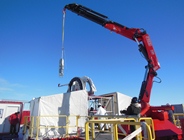Study finds life 800 metres beneath the Antarctic ice sheet

Sediment cores being retrieved from Subglacial Lake Whillans
21 August 2014
WISSARD, an American led study funded by the National Science Foundation to discover life under the Antarctic ice sheet, has published its findings this week.
In late January of 2013 the WISSARD team made scientific and engineering history when they retrieved water and sediment samples from Lake Whillans which lies 800 metres (2600 feet) beneath the Antarctic ice sheet.
Writing in the journal Nature, the team reports that water and sediment samples taken from the lake prove it supports a microbial ecosystem.
Aberystwyth University scientist Dr Andrew Mitchell was one of only two European based scientists to have taken part in the mission.
Dr Mitchell, a researcher at the Department of Geography and Earth Sciences, worked in laboratories located on the ice-shelf above Lake Whillans in Antarctica during December 2012 and January 2013.
His work focused on testing water and sediment samples taken to determine the presence of chemical signals of microbial activity.
Combined with microbial analysis, Dr Mitchell’s work enabled the WISSARD team to build a full picture of the potential ecosystem under the Antarctic ice sheet, its impact on the chemistry of the water and how the microbes release nutrients into the water by literally digesting the rocks.
The microbes use the geology of their environment to release elements trapped in the rocks and release them into the waters, which are eventually flow out into the oceans.
The risk of contaminating the lake with material from the outside world meant an entirely new ‘clean access’ drilling and sampling system had to be developed, and the risk of collected samples becoming contaminated meant that nearly all the chemical analysis was done in specifically designed laboratories installed on the site of the drilling operation.
Dr Mitchell said: “For the very first time this study has demonstrated an active microbial ecosystem and the role of microbes in cycling nutrients deep under ice sheets. These environments may have served as a refuge for life over geological time during periods when the Earth was nearly entirely ice covered.”
“We now know there are more than 400 lakes beneath the Antarctic ice sheet which are linked and this study suggests that significant amounts of carbon and nutrients are probably exported from these sub-glacial lakes into the vast Southern ocean that encircles the continent as a result of the activities of these microbes, providing rich and valuable food sources.”
Dr Mitchell and colleagues at Aberystwyth University are studying the biological and chemical processes that take place in glaciers to understand their impact on climate change.
With financial support from the Higher Education Funding Council for Wales, the team has recently established an Extreme Experimental Environments Lab at Aberystwyth where they study microbiological and chemical processes that occur at extremes of temperature and pressure and aridity – how much water is around.
AU33014



